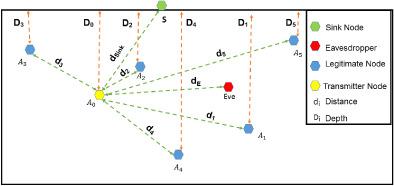当前位置:
X-MOL 学术
›
Trans. Emerg. Telecommun. Technol.
›
论文详情
Our official English website, www.x-mol.net, welcomes your feedback! (Note: you will need to create a separate account there.)
Maximizing secrecy rate of an orthogonal frequency division multiplexing‐based multihop underwater acoustic sensor network
Transactions on Emerging Telecommunications Technologies ( IF 3.6 ) Pub Date : 2020-09-04 , DOI: 10.1002/ett.4106 Waqas Aman 1 , Muhammad M. U. Rahman 1 , Zeeshan Haider 1 , Junaid Qadir 1 , Muhammad W. Nawaz 2 , Guftaar A. S. Sidhu 3
Transactions on Emerging Telecommunications Technologies ( IF 3.6 ) Pub Date : 2020-09-04 , DOI: 10.1002/ett.4106 Waqas Aman 1 , Muhammad M. U. Rahman 1 , Zeeshan Haider 1 , Junaid Qadir 1 , Muhammad W. Nawaz 2 , Guftaar A. S. Sidhu 3
Affiliation

|
In this article, we consider an eavesdropping attack on a multihop, underwater acoustic sensor network that consists of M + 1 underwater sensors which report their sensed data via orthogonal frequency division multiplexing (OFDM) scheme to a sink node on the water surface. Furthermore, due to the presence of a passive malicious node in nearby vicinity, the multihop underwater acoustic (UWA) channel between a sensor node and the sink node is prone to eavesdropping attack on each hop. Therefore, the problem at hand is to do (helper/relay) node selection (for data forwarding onto the next hop) as well as power allocation (across the OFDM subcarriers) in a way that the secrecy rate is maximized at each hop. To this end, this problem of node selection and power allocation (NSPA) is formulated as a mixed binary‐integer optimization program, which is then optimally solved via decomposition approach, and by exploiting duality theory along with the Karush‐Kuhn‐Tucker conditions. We also provide a computationally efficient, suboptimal solution to the NSPA problem, where we reformulate it as a mixed‐integer linear program and solve it via decomposition and geometric approach. Moreover, when the UWA channel is multipath (and not just line‐of‐sight), we investigate an additional, machine learning‐based approach to solve the NSPA problem. Finally, we compute the computational complexity of all the three proposed schemes (optimal, suboptimal, and learning‐based), and do extensive simulations to compare their performance against each other and against the baseline schemes (which allocate equal power to all the subcarriers and do depth‐based node selection). In a nutshell, this work proposes various (optimal and suboptimal) methods for providing information‐theoretic security at the physical layer of the protocol stack through resource allocation.
中文翻译:

最大化基于正交频分复用的多跳水下声传感器网络的保密率
在本文中,我们考虑了对包含M + 1的多跳水下声传感器网络的窃听攻击水下传感器,它们通过正交频分复用(OFDM)方案将其感测到的数据报告给水面上的汇点。此外,由于附近存在被动恶意节点,因此传感器节点和宿节点之间的多跳水下声(UWA)通道易于在每跳上进行窃听攻击。因此,眼前的问题是要进行(辅助/中继)节点选择(用于将数据转发到下一跳)以及功率分配(跨OFDM子载波),以使每个跳的保密率最大化。为此,将节点选择和功率分配(NSPA)问题表述为混合的二进制整数优化程序,然后通过分解方法以及利用对偶理论和Karush-Kuhn-Tucker条件一起对其进行最优求解。我们还为NSPA问题提供了计算有效的次优解决方案,将其重新构造为混合整数线性程序,然后通过分解和几何方法对其进行求解。此外,当UWA通道是多路径(而不仅仅是视线)时,我们研究了一种额外的基于机器学习的方法来解决NSPA问题。最后,我们计算了所有三种建议方案(最优,次优和基于学习)的计算复杂度,并进行了广泛的仿真,以比较它们彼此之间的性能以及与基线方案(将相等功率分配给所有子载波和进行基于深度的节点选择)。简而言之,
更新日期:2020-11-05
中文翻译:

最大化基于正交频分复用的多跳水下声传感器网络的保密率
在本文中,我们考虑了对包含M + 1的多跳水下声传感器网络的窃听攻击水下传感器,它们通过正交频分复用(OFDM)方案将其感测到的数据报告给水面上的汇点。此外,由于附近存在被动恶意节点,因此传感器节点和宿节点之间的多跳水下声(UWA)通道易于在每跳上进行窃听攻击。因此,眼前的问题是要进行(辅助/中继)节点选择(用于将数据转发到下一跳)以及功率分配(跨OFDM子载波),以使每个跳的保密率最大化。为此,将节点选择和功率分配(NSPA)问题表述为混合的二进制整数优化程序,然后通过分解方法以及利用对偶理论和Karush-Kuhn-Tucker条件一起对其进行最优求解。我们还为NSPA问题提供了计算有效的次优解决方案,将其重新构造为混合整数线性程序,然后通过分解和几何方法对其进行求解。此外,当UWA通道是多路径(而不仅仅是视线)时,我们研究了一种额外的基于机器学习的方法来解决NSPA问题。最后,我们计算了所有三种建议方案(最优,次优和基于学习)的计算复杂度,并进行了广泛的仿真,以比较它们彼此之间的性能以及与基线方案(将相等功率分配给所有子载波和进行基于深度的节点选择)。简而言之,



























 京公网安备 11010802027423号
京公网安备 11010802027423号